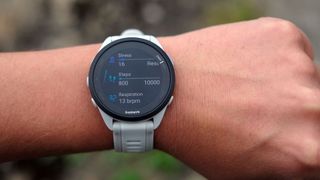The Forerunner 165 is a watch for those folks who like the idea of owning one of the best Garmin watches but flinch at the sight of some of their prices.
It manages to largely represent what Garmin is about these days, for a quarter of the cost of the most expensive watches. The Forerunner 165 has an OLED screen, a relatively high-end array of features and good stat-tracking hardware.
Where’s the catch? Like other Forerunner watches, the Forerunner 165’s build is functional rather than high-end. It lacks many software features both key and peripheral, including on-watch maps. You have to pay more for music support, and some core features are a generation behind.
Even with all that accounted for, though, the Forerunner 165 may well be a more compelling buy than rivals like the Coros Pace 3 or Apple Watch SE. It’s a great all-rounder at $249.99 (£249.99), while the Music edition costs a little more at $299.99 (£289.99).
Garmin Forerunner 165 review
Garmin Forerunner 165: Design
- Light and comfortable to wear
- Reinforced polymer casing
- 5ATM water resistance
Key specs
Screen: 1.2-inch, 390 x 390 pixel OLED
Connectivity: Bluetooth, Wi-Fi
Dimensions: 43 x 43 x 11.6 mm
Sensors: GPS, HR, SpO2, motion
Weight: 39 g
Water resistance: 5ATM
Battery life: Up to 11 days
Storage: 4 GB
Though the Garmin Forerunner series may seem a bit intimidating to Garmin beginners, it might actually be the ideal entry point.
It has a relatively small screen, meaning the watch itself isn’t too huge. There’s hardly any metal here, as the casing is plastic, which helps reduce the weight of the watch to just 1.38 oz (39 g). The Garmin Forerunner 165 may not be as high-end as a Fenix 7 Pro or Enduro 2, but it sure is more comfortable to wear 24/7.
There are, however, some sacrifices on the ruggedness front as a result. The reinforced polymer casing isn’t as hard as stainless steel or titanium, and the Forerunner 165’s “chemically strengthened” glass screen protection is not the best around either.
The bezel is also raised just the smallest amount above the screen. A raised bezel is a classic protective tactic. That said, five months in, the watch still has no visible damage.

These plastic Garmin watches are pretty hardy, and similar designs are used all the way up to the Forerunner 965. This watch’s water resistance is limited, however, compared to that of the best Garmins in the range.
It’s rated to 5ATM. While on paper this means it can handle depths of up to 164 feet (50 meters), this is not a watch for diving, or even swimming that far below the surface. That’s because those water resistance numbers don’t factor in the additional pressure of actually moving through water.
That said, Garmin doesn’t want you to fear the pool — there are both swimming pool and outdoor swim tracking modes preinstalled.

Garmin Forerunner 165: Screen and control
- Crisp and colorful 1.2-inch OLED screen
- Button controls and a touchscreen
The Forerunner 165 has an OLED screen, like an Apple Watch. This tech has gradually spread across the Garmin range over the last four years because the tech has become better, less expensive to implement and less of a power drain.
This is a 1.2-inch screen that looks as sharp as the display of any Garmin. There are zero issues with visibility outdoors on a bright day, and the punchiness and sharpness indoors are far better than that of Garmin’s classic transflective screens.
Older Garmin watch displays feed off ambient light and barely use any power. They still have their place, but for the everyday casual runner, cyclist or gym-goer, OLEDs may well be more appealing.

The Forerunner 165 merges this smartwatch-like screen tech with largely button-led control. Five buttons sit on the watch’s sides. Think that seems kind of retro? Not in a fitness watch. It makes it much easier to avoid accidentally stopping or pausing a tracked exercise session halfway through. Almost nothing will make you fall out of love with a watch faster than that.
This is actually one of the key benefits of the Forerunner 165 over something like the Garmin Venu 2. Flicking through your daily stats using the buttons is also far quicker than using touch gestures. Touch control is an option, though, as this is still a touchscreen.

Garmin Forerunner 165: Fitness Features
- Great tool for runners
- The lack of on-screen maps is not a deal-breaker
- Some advanced tracking stats are missing
The most important part of figuring out if this watch is for you is getting your head around its limitations. For some folks, a Forerunner 165 will be just as useful as a Forerunner 965 or Fenix 7 Pro. For others, it will be a cut too far.
It doesn’t have on-screen maps, for example. You can’t use it to control a bike turbo trainer. Some of Garmin’s best stats are totally missing — training load and performance condition are the most important. And while there are lots of activity modes baked in, there are no full triathlon modes here: you’d have to log the run, swim and cycle parts separately.
This is still the cheapest OLED Garmin watch that feels like a serious tool for athletes and fitness, though. Some of the stuff you get here might genuinely make a real difference.

For example, the Forerunner 165 provides suggested workouts for runners, informed through your activity level and how tired/ready the watch thinks you are. And while there are no full on-watch maps, you can plan routes on your phone and send them to the Forerunner 165. It’ll tell you when you make turns, when you’re off course — everything but seeing the map itself. This is a fantastic feature.
And while, as mentioned earlier, the Garmin Forerunner 165 doesn’t have some of the athlete-favorite Garmin stats, there are still great ways to check your progress.
The watch will show you an estimate of your VO2 Max and offer predicted race times for everything from a 5K run to a marathon. We always find these a bit optimistic (as in all Garmin watches)… unless maybe we’re just not pushing as hard as Garmin thinks we can! But they are consistently aggrandizing across the higher-end watches from Garmin, too.
Garmin Forerunner 165: Health and smart features
- Measures stress, sleep and blood oxygen
- Morning Report helps with daily tracking

The Forerunner 165 lacks Garmin’s most recent headline-bothering feature, ECG heart rate readings. However, it makes a solid all-day tracking and health watch.
It can send alerts when it senses unusually high-stress levels or unusual heart rate results. There’s also Garmin’s long-standing blood oxygenation reader, Pulse Ox. I’ve seen less obviously errant readings from it here than in earlier Garmins, but would still not advise putting too much stock in any single-reading results, particularly if they are showing as abnormal.
The Forerunner 165 will keep an eye on your stress levels and, if you wear it overnight, track your sleep and heart rate variability. Like most watches, this one will often miss moments when you wake up in the middle of the night, but its Morning Report feature is potentially a great way to start the day.
This pops up when you first interact with the watch each morning and offers a sleep summary, weather report and other bits relevant to your day. It’s such a quick-fire bulletin, that you’re unlikely to get unhealthily obsessed with its stats, and its overall take on a night’s sleep seems mostly sound.

Despite being a lower-end model, the Forerunner 165 also has access to Garmin’s Connect IQ app store, which is home to a reasonable selection of (admittedly mostly quite simple) apps. The watch can also receive notifications and messages from your phone, sourced from whatever apps you green-light. These look good on the sharp OLED screen.
The Forerunner 165 is not a smartwatch, despite the app store and support for the basics. But it can still do the things many appreciate the most in a smartwatch.
Garmin Forerunner 165: Performance

- Accurate heart rate tracking
- Good GPS signal retention
- Always-on mode drained our battery
Cutting back just a little on sensor hardware is one way Garmin kept the Forerunner 165 price down.
It has the company’s Elevate v3 heart rate hardware, as used in the Fenix 7 but not the Fenix 7 Pro. The difference? Garmin’s latest design uses an additional bank of LEDs that fire during tracked exercise to improve heart rate accuracy.
The Forerunner 165 also lacks one of the trendiest (in geeky circles) fitness tracker features: dual-band GPS. This makes use of another frequency band to improve location-tracking reliability in trickier spaces, like forests or cities packed with high-rise buildings.
While the Forerunner 165’s GPS faltered a couple of times under thicker canopies (particularly rain-soaked ones) during our tests, you do generally get a high-end experience here. That’s typified by good signal retention, fast lock-on and highly accurate location tracking — something you can see for yourself with each exercise, thanks to the route maps sent over to the Garmin Connect app.

Heart rate tracking accuracy is good too. There’s none of the classic early session overshoot of less capable wearables. It doesn’t gradually lose its way during longer runs and the Forerunner 165 holds up fairly well during interval sessions.
It’s only in the gym that the watch can prove a little lacking at times. When sets might only amount to 45 seconds, the watch can lag to the extent that its heart rate readings seem useless. And on occasion, it will show flat-out wrong results if you end up gripping part of the exercise equipment — this could have as much to do with the resulting muscle/tendon contraction in your wrist confusing the sensor as the lack of motion.
It’s also important to have the right stamina expectations of the Forerunner 165. Garmin rates it for up to 11 days of use. However, we were able to drain it within four days. This is thanks to the “always on” mode.
As standard, the watch display will only light up when you flick your wrist to your face or press the touchscreen/a button. You can also set it to display the time all day, and stay lit during exercise. That’s the always-on mode. In this mode, the Forerunner 165 is at its best, but it has a huge effect on battery life. Music playback is a real battery-killer too, reducing battery life to a matter of hours.

Should you buy the Garmin Forerunner 165?

The Forerunner 165 is an excellent fitness watch that avoids perhaps the most off-putting aspect of Garmin trackers: their frequently sky-high prices. But it still has advanced features, it still has an OLED screen, and it can still do more than most people need.
Don’t assume you need more than what’s on offer here. Exceptions will include triathletes who want the neatest tracking, those who want to be able to construct routes on-watch or see full maps, and cyclists keen on using the watch for structured turbo trainer workouts. Some may also find its battery life restrictive, at least if you choose to use the best and most power-hungry modes.
For everyone else, though, the Garmin Forerunner 165 comes highly recommended.
If the Garmin Forerunner 165 isn’t for you
The Coros Pace 3 is one of the keenest rivals to the Forerunner 165 if budget is the guiding factor. It’s an impressive watch, too: its battery lasts longer, and you can send routes to it for on-watch navigation. It’s compelling, but the Forerunner 165 has a much slicker interface, better implementation of route planning and a killer workout/training system.
Want to stick with Garmin? The Forerunner 265 is the next step up. It adds multi-band GPS, has better battery life, supports turbo trainer control and has music support as standard, as well as the more advanced statistics that the Forerunner 165 lacks. It’s a better watch — whether it’s worth an additional $200 or so is up to your bank balance.
How we tested

We used the Forerunner 165 for more than five months, mostly tracking regular runs and gym sessions.
It has been worn for upwards of 1,600 miles (1,000 kilometers) of GPS-tracked running and hiking, and used in multiple modes to get the best idea of its real-world battery life. This has been a long, day-in/day-out relationship.















